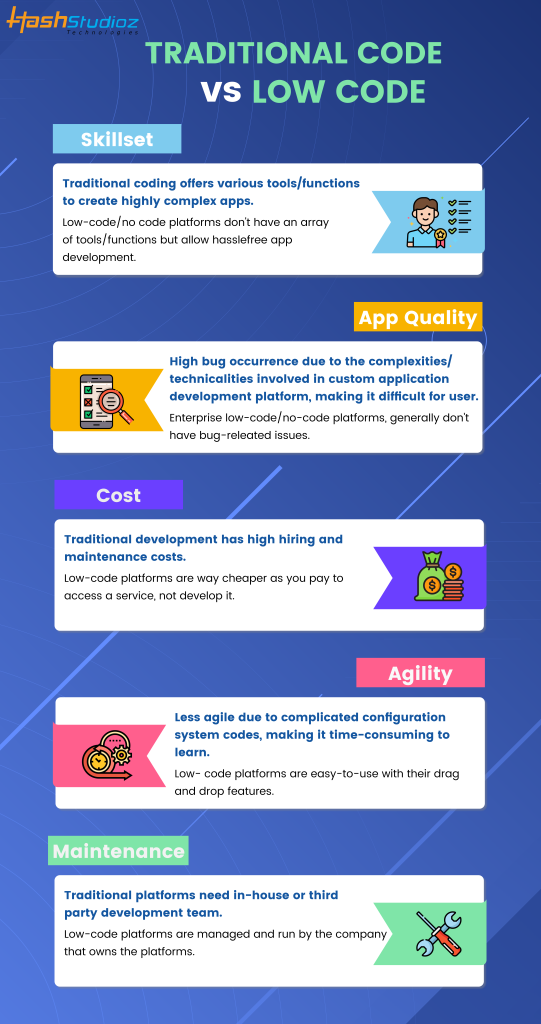Because of a variety of key factors, Low-code Application Development is a possibility for people who are not developers. They are also known as "citizen designers."
Drag-and-Drop Builders: Low-code platforms have drag-and-drop interfaces which allow non-developers to build applications without needing to write code. This makes development easier for those with no technical backgrounds.
WYSIWYG editors: These "What You See is What You Get" editors allow users to create workflows and interfaces that are identical to the finished version. This makes it much easier to understand and use.
Simplified Workflow and Logic Design:
Visual Workflow modeling: Users create business processes and application logic with visual flowcharts. The models are simpler to work with than traditional code methods.
Low-code platforms usually come with pre-built logic elements (e.g. the conditional statements, loops) that eliminate the need for complicated coding.
Reusable templates and components:
Library of Templates Pre-built: Numerous platforms that provide low-code also have templates that are suitable for most applications. This allows developers to start quickly and efficiently, while non-developers can customize the templates to their own preferences. appropriate.
Reusable Modules and Widgets: Users can make use of reusable widgets and modules to streamline the process of creating them and reducing the need for in-depth technical knowledge.
Guided Development and Tutorials:
Step-by-Step Guides: Platforms often offer guided development paths, online tutorials, or on-screen instructions to assist users who aren't developers to create applications.
Interactive Tutorials Interactive tutorials that are hands-on and interactive allow users to learn through doing, enhancing their comprehension and confidence making use of the platform.
Integration with tools already in use
Seamless Integration - Low-code platforms can be easily integrated with existing systems and tools for business (e.g. ERP CRM), allowing even non-developers to develop apps that work into their workflows.
APIs and Connectors : APIs integrated into connectors and APIs enable non-developers and users to easily connect their applications to external services without the need for complicated code.
Collaboration Features:
Team Collaboration: real-time collaboration, shared workspaces, and shared workspaces allow business analysts, non-developers and other stakeholders to effectively work alongside professional developers.
Access Control based on Role: Users who are not developers can be assigned roles, with appropriate access levels. This allows them to participate in the development process without compromising security and performance.
Automated Testing, Debugging and Debugging
Built-In Testing Tools: Low-code platforms often include built-in testing and debugging tools that automate these procedures, making it much easier for non-developers and users to ensure that their apps function properly.
Error Highlighting - When problems arise, the platform highlights them and suggests solutions, while guiding users through troubleshooting.
Overall, the main advantage of developing applications using low-code in terms of accessibility to non-developers stems due to its ability to decentralize the development process. Low-code platforms provide intuitive visual tools, guiding user experiences, and allow business users to actively participate in creating apps, maintaining them and updating them. Follow the most popular Low-code Platform for application development for more tips including cross platform mobile app development, app modernization, sso azure, sso azure, rapid applications, stored sql procedures, rapid action development, app dev platform, rapid application design, microsoft azure sql and more.

Benefits Of Low-Code Applications In Safety And Governance
Low-code applications offer several benefits for governance and cybersecurity, which is crucial to ensure that applications are properly managed, controlled and in compliance throughout their livescycle. These are the main advantages.
Unified Management console: A low-code platform typically provides a central dashboard that administrators can use to control and monitor all applications to ensure consistency in governance throughout the entire organization.
Role-Based Access Control RBAC: These platforms come with robust role-based controls that allow administrators to set access rules. This ensures that only users who are authorized have the ability to access or modify particular areas of the application.
Compliance and Regulatory Adherence
Built-in Compliance Features: Many low-code platforms are built to comply with industry standards and regulations (e.g., GDPR, HIPAA). They provide tools and templates to ensure that applications comply with these standards.
Audit Trails and Logging: Comprehensive logging and audit trails are typically integrated, allowing companies to track changes, monitor access and ensure compliance with internal and external regulations.
Increased Security Measures
Data Encryption. Low-code platforms offer encryption that is built into information both in the state of rest and while it's being transferred, which ensures sensitive information remains protected.
Security Certifications - A lot of lowcode companies have security certifications, such as ISO 27001 (or SOC2) that demonstrate their adherence to the highest security standards. Users can be assured that these providers adhere to the standards.
Automatic security updates for security:
Regular security updates and patches Low-code platforms handle automated security patches, updates and upgrades. The applications are thus protected from the latest threats without requiring manual intervention by developers.
Security Monitoring: Constant security monitoring tools can be included to provide real-time notifications as well as information about potential security problems.
Data Governance
Data Access Policy: These systems let organisations define and enforce policies for access to data, while making sure that only authorized users have access to data and that it is used properly.
Data Masking and Anonymization: Inbuilt tools for masking data and anonymization protect sensitive data, particularly in the testing and development environment.
Consistent Lifecycle Application Management:
Pipelines for Development and Deployment Low-code platforms usually offer integrated pipelines for development and deployment that incorporate security checks, ensuring that security is maintained throughout the application lifecycle.
Version Control: The integrated version control helps manage modifications and makes sure that changes to the application will be identified and changed if necessary, maintaining the integrity of the application.
User authentication:
Single Sign-On (SSO): Single sign-on support and other advanced authentication techniques simplifies user management and enhances security.
Multi-Factor Authentication: Many platforms have built-in support of multi-factor authentication. This adds an additional layer of security to applications.
Policy Enforcement and Compliance Monitoring:
Low-code platforms usually come designed with policies that are pre-defined to assist organizations in implementing security and governance policies swiftly.
Tools for Monitoring Compliance These tools track and provide continuous reports on compliance status. They allow you to identify issues and tackle them in a proactive manner.
Integration with Existing Security Infrastructure:
Seamless Integrate: Low-code platform are designed to work seamlessly with the existing security infrastructure and tools, such as identity management tools SIEMs (Security Information and Event Management Solutions), and firewalls.
API Security: API integrated security guarantees that integrations with other systems are secure. Secure data and ensure application consistency.
Training and best Practices
Best practices for guideline: Several platforms provide guidelines and recommended methods for developing secure applications. They help non-developers comply with security standards.
Security Training: Certain providers of low-code offer education and resources in security to educate users about how to build and maintain secure applications.
All in all, low-code app developers have a security and governance advantage which allows them to create and manage applications in a safe, secure and secure manner. These platforms offer the necessary frameworks and tools to safeguard sensitive data and enforce policies, as well as maintain regulatory compliance while simplifying managing and monitoring. Have a look at the top this hyperlink for Enterprise application development with Low-code Platform for website recommendations including app modernisation, driver jdbc, azure sql databases, rapid action development, application modernisation, no code platforms, rapid applications, no code platforms, low code development platforms, rad application development and more.

The Benefits Of Developing Low-Code For Collaboration And Workflow
It's a great option for companies that wish to increase team productivity as well as streamline processes and enhance collaboration. Here are the major benefits: Improved Collaboration Across Functions:
Unified Development Environment Low-code platform provides a single unified environment, where all members of the team, including developers, analysts, designers, stakeholders and more, can efficiently work together. This helps reduce the number of silos and enhances communication.
Visual Development Tools Low-code platforms are straightforward to use and have the drag-and-drop interface. This lets non-technical members of the team to take part during the development process, which ensures that business requirements are captured in a precise manner.
Enhanced Communication
Real-Time Co-operation: Many platforms that have low-code support live-time collaboration features such as commenting, editing simultaneously and getting immediate feedback. They allow for constant communication, reducing the time needed for back-and-forth discussions.
Workspaces shared by teams. Teams can collaborate in shared workspaces. Here, they can see, edit, and talk about various project components.
A streamlined workflow management system:
Integrated Project Management Tools: A lot of low-code software platforms include integrated tools for project management which can assist teams to track and organize their projects for development. This includes tasks assignation, progress monitoring, and deadlines management.
Workflow Automation: Automating repetitive tasks and workflows can reduce errors and manual labor and allows teams to focus on more strategic tasks and enhancing overall efficiency.
Speedier Iteration cycles
Rapid prototyping: Low-code platforms permit rapid prototyping rapid development, iterative development, and prototyping, which allows teams to create applications, test them and refine them in shorter cycles. This allows feedback to be quickly incorporated, and improvements can be implemented.
Support for agile development: Supporting agile methodologies allows teams to collaborate continuously during sprints. This makes it easier to change and deliver smaller steps to improve capabilities.
Accessibility to non-developers
Citizen Development: Low-code platforms allow business users the ability to develop and modify applications without extensive coding skills. This eases the workload on IT teams and developers, allowing them to respond more quickly to business needs.
Onboarding and Training. The intuitive interfaces of training tools help new members to be familiar with the system and this helps improve teamwork.
Centralized documentation knowledge sharing, dissemination and documentation:
Integrated documentation: Low-code platform features often permit you to create and manage documents within the platform. All information about your project will be centralized and easily accessible.
Knowledge Repositories : Teams are able to create knowledge repositories, which include templates, best practices and reused components. This helps in sharing knowledge and reduces duplication of efforts.
Standardization and consistency:
Standardized components: Using pre-built, standard components guarantees consistency across applications, making it simpler for teams to comprehend and work on different aspects of a project.
Governance and Compliance - Built-in governance frames ensure that the development of every application conforms to the organizational standards as as regulatory standards. This helps reduce risks of non-compliance as well as ensure that the application is compliant with the highest quality standards.
Feedback loops:
Integrated Feedback Systems: Low code platforms offer integrated feedback systems that permit users to offer feedback to the applications. The feedback could later be utilized in the creation of these applications.
Continuous Improvement: The capability to quickly test deployment, change and deploy applications based on user feedback allows them to be aligned with the business objectives and user demands.
Visualization & Reporting
Real-time Analytics: Built-in analytics and reports provide real-time insights into project performance, user interactions and development. Data-driven decision-making is possible.
Visual Workflow Maps: Software for mapping processes or workflows are useful to teams in understanding their workflows. They can also identify bottlenecks, and areas that require improvement.
When it comes to collaboration, low-code apps are ideal for reducing workflows, bring diverse teams together and streamline tasks. This leads to an efficient and flexible development environment that is collaboration-oriented.
